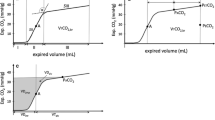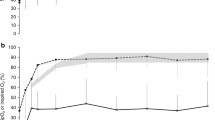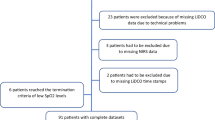Abstract
Purpose
The aim of this study was to elucidate the magnitude of variations in oxygenation indices and the pattern of hemodynamic changes in response to the net effect of tracheal apneic oxygenation (AO) with a view to define the safe time limit of its application.
Methods
After obtaining Animal Research Ethics Committee approval, AO was applied in 12 piglets for 40 min. Arterial (a) and mixed venous (v) blood samples for oxygen (O2) and carbon dioxide (CO2) tension (PaO2/PvO2, PaCO2/PvCO2), O2 saturation (SaO2/SvO2), pHa, base excess (BEa), and bicarbonate (HCO3a) determination and for alveolar O2 tension (PAO2), PaO2/FiO2 and PaO2/PAO2 ratio, arterial–mixed venous O2 content (AVDO2), and O2 extraction ratio (O2ER) estimation were collected on anesthesia induction, 10, 20, 30, and 40 min during AO and 10 and 20 min after reconnection to the ventilator. Concomitant hemodynamic data were obtained.
Results
Besides PvO2 and PAO2, AO adversely influenced PaO2 (248–113 mmHg), PaCO2 (35–145 mmHg), PvCO2, PaO2/FiO2, and PaO2/PAO2 in a time-depended fashion, whereas SvO2, AVDO2, and O2ER were minimally affected. P(a − v)CO2 was reversed throughout AO. Acid–base status derangement, consisting of HCO3a elevation, BEa widening, and acidemia (pH 6.9) maximized 40 min after AO. During AO, heart rate, systemic and pulmonary circulation pressures, and cardiac output were progressively elevated, whereas systemic vascular resistance was reduced. All the studied parameters reverted almost to baseline within the 20-min period of ventilator reconnection.
Conclusion
Tracheal AO for 40 min ensures acceptable blood oxygenation, promotes notable hypercapnic acidosis, and consequent transient hemodynamic alterations, which are almost completely reversible after reconnection to the ventilator.

Similar content being viewed by others
References
Watson JNR, Szarko R, Mackenzie FC, Sequeira JA, Barnas MG. Continuous endobronchial insufflation during internal mammary artery harvest. Anesth Analg. 1992;75:219–25.
Lee SC. Improvement of gas exchange by apneic oxygenation with nasal prong during fiberoptic intubation in fully relaxed patients. J Korean Med Sci. 1998;13:582–6.
Lang CJ, Heckmann JG. Apnea testing for the diagnosis of brain death. Acta Neurol Scand. 2005;112:358–69.
Weingard SD, Levitan RM. Preoxygenation and prevention of desaturation during emergency airway management. Ann Emerg Med. 2012;59:165–75.
Mort TC. Emergency tracheal intubation: complications associated with repeated laryngoscopic attempts. Anesth Analg. 2004;99:607–13.
Taha SK, Siddik-Sayyid SM, El-Khatib MF, Dagher CM, Hakki MA, Baraka AS. Nasopharyngeal oxygen insufflation following pre-oxygenation using the four deep breath technique. Anaesthesia. 2006;61:427–30.
Engström J, Hedenstierna G, Larsson A. Pharyngeal oxygen administration increases the time to serious desaturation at intubation in acute lung injury: an experimental study. Crit Care. 2010;14:R93.
Ramachandran SK, Cosnowski A, Shanks A, Turner CR. Apneic oxygenation during prolonged laryngoscopy in obese patients: a randomized, controlled trial of nasal oxygen administration. J Clin Anesth. 2010;22:164–8.
Baraka AS, Taha SK, Siddik-Sayyid SM, Kanazi GE, El-Khatib MF, Dagher CM, Chehade J-MA, Abdallah FW, Hajj RE. Supplementation of preoxygenation in morbidly obese patients using nasopharyngeal oxygen insufflation. Anaesthesia. 2007;62:769–73.
Smith RB, Babinsky ME, Bunengin L, Gilbert J, Swartzman S, Dirting J. Continuous flow apneic ventilation. Acta Anaesthesiol Scand. 1984;28:631–9.
Burwen DR, Watson J, Brown R, Josa M, Slutsky AS. Effect of cardiogenic oscillations on gas mixing during tracheal insufflation of oxygen. J Appl Physiol. 1986;60:965–71.
Cook TM, Wolf AR, Henderson JW. Changes in blood-gas tensions during apnoeic oxygenation in paediatric patients. Br J Anaesth. 1998;81:338–42.
Frumin JM, Epstein RM, Cohen G. Apneic oxygenation in man. Anesthesiology. 1959;20:789–98.
Ingenito E, Kamm RD, Watson JW, Slutsky AS. A model of constant-flow ventilation in a dog lung. J Appl Physiol. 1988;64:2150–9.
Dincer HE, O’Neill W. Deleterious effects of sleep-disordered breathing on the heart and vascular system. Respiration. 2006;73:124–30.
Ebata T, Watanabe Y, Amaha K, Hosaka Y, Takagi S. Haemodynamic changes during the apnoea test for diagnosis of brain death. Can J Anaesth. 1991;38:436–40.
Fraioli RL, Sheffer LA, Steffenson JL. Pulmonary and cardiovascular effects of apneic oxygenation in man. Anesthesiology. 1973;39:588–96.
Draper WB, Whitehead RW. Diffusion respiration in the dog anesthetized by pentothal sodium. Anesthesiology. 1944;5:262–73.
Enghoff H, Holmdahl MH, Risholm L. Diffusion respiration in man. Nature. 1951;168:830.
Holmdahl MH. Pulmonary uptake of oxygen, acid base metabolism and circulation during prolonged apnoea. Acta Chir Scand Suppl. 1956;212:1–128.
Nielsen ND, Kjaergaard B, Koefoed-Nielsen J, Steensen CO, Larsson A. Apneic oxygenation combined with extracorporeal arteriovenous carbon dioxide removal provides sufficient gas exchange in experimental lung injury. ASAIO J. 2008;54:401–5.
Nielsen ND, Granfeldt A, Kjaergaard B, Vistisen ST, Larsson A. A new method for reducing the risk of oxygen toxicity in apneic oxygenation with extracorporeal CO2 removal. Intensive Care Med. 2009;35(Suppl. 1):S188.
Hostman S, Engstrom J, Sellgren F, Hedenstierna G, Larsson A. Non-toxic alveolar oxygen concentration without hypoxemia during apnoeic oxygenation: an experimental study. Acta Anaesthesiol Scand. 2011;55:1078–84.
Nielsen ND, Andersen G, Kjaergaard B, Staerkind ME, Larsson A. Alveolar accumulation/concentration of nitrogen during apneic oxygenation with arteriovenous carbon dioxide removal. ASAIO J. 2010;56:30–4.
Agarwal A, Singh PK, Dhiraj S, Pandey CM, Singh U. Oxygen in air (FiO2 0.4) improves gas exchange in young healthy patients during general anesthesia. Can J Anaesth. 2002;49:1040–3.
Shapiro B. The apnea–PaCO2 relationship: some clinical and medico-legal considerations. J Clin Anesth. 1989;5:323–7.
Eger EI, Severinghaus JW. The rate of rise of PaCO2 in the apneic anesthetized patient. Anesthesiology. 1961;22:419–25.
Laffey JG, Kavanagh BP. Carbon dioxide and the critically ill—too little of a good thing? Lancet. 1999;354:1283–6.
Rigg CD, Crickshank S. Carbon dioxide during and after the apnea test—an illustration of the Haldane effect. Anaesthesia. 2001;56:377.
Solsona JF, Diaz Y, Gracia MP, Gener J, Vázquez A. PaCO2 becomes greater than PvCO2 during apnoea testing for brain death diagnosis. Anaesthesia. 2010;65:306–15.
Blaze CA, Robinson NE. Apneic oxygenation in anesthetized ponies and horses. Vet Res Commun. 1987;11:281–91.
Nunn JF. The effects of changes in the carbon dioxide tension. In: Nunn’s applied respiratory physiology, 4th edn. UK: Butterworth-Heinemann; 1993. pp. 518–528.
Millar RA. Plasma adrenaline and noradrenaline during diffusion respiration. J Physiol. 1960;150:79–90.
Moudgil R, Michelakis E, Archer S. Hypoxic pulmonary vasoconstriction. J Appl Physiol. 2005;98:390–403.
Lynch F, Sweeney M, O’Regan RG, McLoughlin P. Hypercapnia-induced contraction in isolated pulmonary arteries is endothelium-dependent. Respir Physiol. 2000;121:65–74.
Mackenzie CF, Barnas G, Nesbitt S. Tracheal insufflation of oxygen at low flow: capabilities and limitations. Anesth Analg. 1990;71:684–90.
Conflict of interest
None.
Author information
Authors and Affiliations
Corresponding author
About this article
Cite this article
Kolettas, A.A., Tsaousi, G.G., Grosomanidis, V. et al. Influence of apneic oxygenation on cardiorespiratory system homeostasis. J Anesth 28, 172–179 (2014). https://doi.org/10.1007/s00540-013-1714-5
Received:
Accepted:
Published:
Issue Date:
DOI: https://doi.org/10.1007/s00540-013-1714-5




